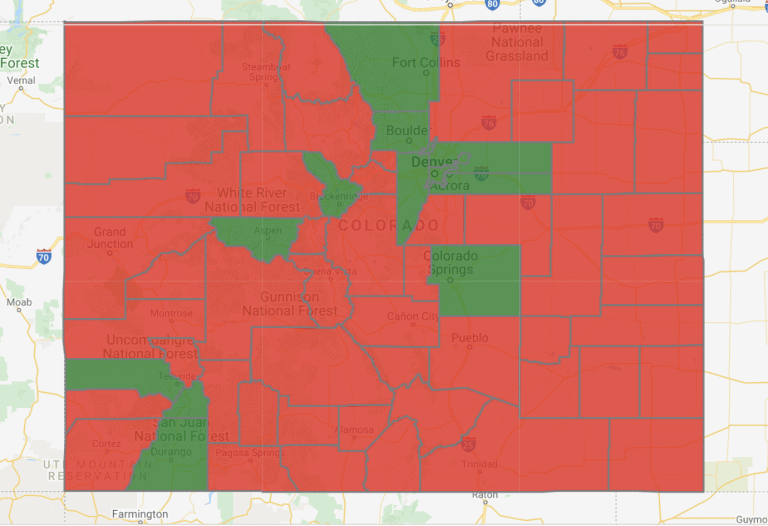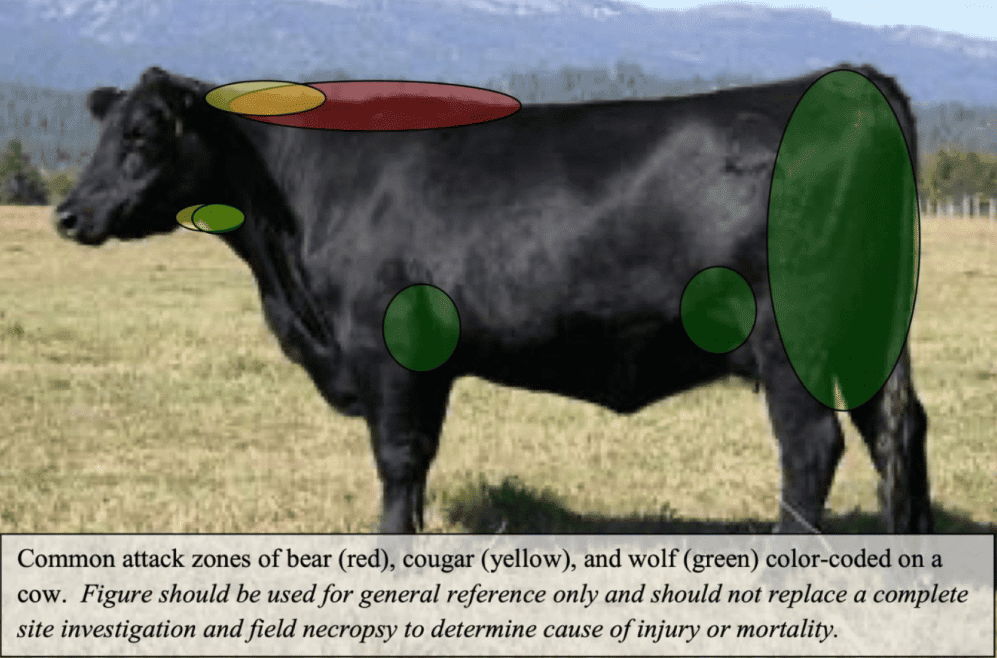It’s fascinating to me that scientists are thought to be able to predict movement of wildlife populations in fifty years due to climate change, but we don’t actually understand what makes them tick (or not, in this case). In my view, better models are built from understanding what makes animals tick.. physiology, behavior, genetics, diseases, predation, and so on.
Mysterious Deaths of Cattle Near Meeker Colorado
This has attracted the attention of media across the country and in Britain.
The best one I’ve read for those interested in the details of biology, was written by the Klinglesmith family who owns the dead calves. It’s an interesting story of how the ranchers, Colorado Parks and Wildlife, Wildife Services, and various diagnostic laboratories have worked together to figure out what happened. The article even has references. Apparently the cause is till not clear. Warning: some of the photos are graphic.
This whole process has taught us that these investigations will require a lot of time and effort on the part of CPW staff and landowners in rural Colorado. We promise to continue to work with the local staff here in Rio Blanco County to figure out whether wolves are present or if there is another explanation for the apparent stress and trauma these calves suffered.
As a multi-generational ranching family, we are committed to running a progressive livestock and wildlife operation. However, we are also committed to working with those in our state and keeping them updated on our scenario.
Bridging the gap that exists between urban and rural is important to us. The future of livestock production in our state remains equally important. We understand this is a highly contentious issue, but hopefully we can agree on the fact that collaboration is key to working toward a solution. The relationship between state agencies, livestock associations, the Colorado public, and ranching families is crucial in moving forward with the process of coexisting with all wildlife on our landscape.
Colorado Draft Wolf Reintroduction Plan Coming Out
Comprehensive story on CPR here. Worth a read for those interested. CPW seems to have really engaged with the public on this one, certainly not an easy task.
Adding More Wolves to Colorado, Why?
So you may wonder why Colorado is adding more wolves when it already has them. Here’s a bit of history to give context.
You’d have to ask the folks (mostly urban) who voted for the state ballot initiative to reintroduce them. At the time there were two schools of thought, one that they were coming in naturally, so why mess with Mother Nature, and the other.. I guess they felt Mother Nature needed help. But isn’t that unnatural? Oh well. Here’s where the $ came from. Sorry about the ad in my screenshot.
 Here’s the county votes..green came out for and red against the initiative.
Here’s the county votes..green came out for and red against the initiative.
The vote ended up being very close,  Now a ballot initiative is an interesting critter. It’s a simple vote, so there is no analysis of say, impacts to communities. Effectively, and unilaterally, urban areas are able to impact rural communities. Even though the urban areas may have higher incomes, which in other contexts might trigger social justice concerns. In fact, Catholic moral theologians could probably have an entire conference devoted to whether this kind of decision-making follows the social justice principle of subsidiarity or not.
Now a ballot initiative is an interesting critter. It’s a simple vote, so there is no analysis of say, impacts to communities. Effectively, and unilaterally, urban areas are able to impact rural communities. Even though the urban areas may have higher incomes, which in other contexts might trigger social justice concerns. In fact, Catholic moral theologians could probably have an entire conference devoted to whether this kind of decision-making follows the social justice principle of subsidiarity or not.
But it is what it is, and the CPW folks seem to be doing their best to honor the views of those impacted.
We Still Don’t Understand About SW Colorado Elk Calves
Interesting article by Bruce Finley today in the Denver Post. There may be a paywall.
But in southwestern Colorado elk have been decreasing for two decades from more than 140,000 to around 122,000 – raising concerns. Elk calf survival rates south of Interstate 70 are estimated at 30 or so per 100 cows, compared with rates in northwestern Colorado near Craig and Steamboat Springs around 58 calves per 100 cows.
Going back to the previous article, northwestern Colorado is the area potentially planned for wolf reintroduction, and already has wolves moving in.
CPW crews also are conducting research into why more calves aren’t surviving.
The forces impeding elk survival include loss of habitat and degradation due to roads, traffic, energy development, and increased residential and commercial construction along migration routes. Surging recreational activities in western Colorado also complicates elk survival.
State and federal ecologists point to climate warming as a factor, favoring hot and dry conditions that reduce vegetation elk in southwestern Colorado need. Aridity in some areas is shrinking vegetation that elk eat and that provides cover for calves facing predators: coyotes, bears and mountain lions.
Now it seems like we know what elk eat, and what they use for hiding cover for their calves, thanks to observations and generations of researchers. And it seems like different years are wetter or drier. For example check out this map of Colorado’s water year 2022. where many parts of SW Colorado seem to be doing quite well. So if it were climate warming, then CPW or someone could compare calf survival in years with more grass and less grass, or even elevations with different physical conditions. Perhaps that’s what CPW is looking at. Looks like there have been calf declines in other places as well. , in this example South Dakota. Maybe those folks figured out what was going on?


Too bad for the ranchers. It’s my understanding that they can’t shoot for depredation anyway.
A lot of CPW is switching from being an agency mainly concerned with hook and bullet to one that gets funding for various wildlife projects. Wolves can be a huge bonanza, and I think the number of salaries paid by the wolf issue will skyrocket. Imagine the personel required if they have hundreds of livestock depredations per month, or people complaining about dogs getting eaten. In a state as populated as Colorado I can well imagine tons of conflicts.
Lots of salaries for people with “people skills” more than law enforcement or hunting/tracking/biology type things.
We’ve switched. I didn’t hunt elk this year. Freezer is empty for the first time in almost 2 decades. Sirloin in big pieces from the Costco business store. Tastes good to me.
What’s frustrating is that lately land managers have been blaming recreation for declining elk numbers and enacting all kinds of seasonal closures (mainy for motorized users, but also in some cases for non-motorized users) in the name of protecting elk. Now we’re importing a major predator of elk, which will of course lead to a lot bigger declines in elk populations. I know motorized groups in particular are worried that will inevitably result in further restrictions on recreation, since recreation makes an easy scapegoat when they can’t do anything about the actual cause of elk mortality.
“Now a ballot initiative is an interesting critter.”
If by “interesting critter” you mean “demonstration of mob rule” then I agree…
I can’t vouch for this source, but it summarizes my impression of what I’ve been generally been reading. You can read many arguments from interests on both sides, but it seems like wolves tend to take elk that are old or sick and not likely to reproduce any way.
“Since the restoration of wolves in 1995 and 1996 the elk populations in Montana, Wyoming, and Idaho have actually increased. Montana has seen the highest increase in elk numbers, with the population nearly double that of the state’s management goal. Wyoming and Montana have each had to increase the number of doe tags that are awarded to hunters in an effort to reduce the elk population. Many people will point to the local decline in the elk herds in Yellowstone National Park as evidence that wolves are killing too many elk, but evidence shows that the elk herd is now close to it’s historical average and has stabilized around 7,000 animals.”
https://www.wolfeducation.org/myths-facts#:~:text=Colorado%20Wolf%20and%20Wildlife%20Center,FACTS&text=Wolves%20have%20decimated%20elk%20populations%20in%20Idaho%2C%20Montana%2C%20and%20Wyoming.&text=close%20to%20it's%20historical%20average%20and%20has%20stabilized%20around%207%2C000%20animals.
Hmmm, not sure the wolf education organization is an unbiased source. Most of the peer-reviewed journals in JWM, WSB, PLOS One, etc., find a pretty strong elk decline signal when wolves move in. My guess is that deep snow years are a big mortality factor – but taking a cue from the East, where bear and coyote numbers have exploded and you see declining calf:cow ratios in deer (despite high adult doe survival), the culprit is fawn predation. Recruitment simply gets lowered and then in some years to the point that it is lower than replacement on adult mortality. Certainly, fewer deer, and I suspect elk are a good thing for some environmental components, however, to not assume adding wolves to a system that has bears, cougars and coyotes to not have an impact defies logic (and published research).
“Subsidiarity, however, is not mere local control. In fact, the word comes from the Latin “subsidium,” meaning to provide aid. So, the principle of subsidiarity is really about the duty of the higher order to provide assistance to the lower order when appropriate.” It looks like the debate should be whether it is appropriate to provide assistance when a decision adverse to a “lower order” group is made by the “higher order.” And then whether that decision should still be made if it triggers the need for such assistance.
Jon,
Yes, well, that’s why Catholic moral theologians would have many conferences about it.
There’s a certain ambiguity that goes with it.. the higher level should not absorb the effective functions of smaller ones. This Jesuit writes “This (Pope Pius 1931 Encyclical) was in part a reaction against the centralizing tendencies of socialism at the time. However, if smaller, more localized entities cannot or will not cope adequately with a problem, then larger entities—the state, for instance—have a responsibility to act.”
Who decides what is “coping adequately”? Asking for help (from those who need it) is different from telling others what to do (it’s for your own good). It doesn’t matter in some sense if the sense of superiority is caused by moral judgement or the feeling of superior knowledge, the lack of political agency may well feel the same. Acknowledging here 1) that there are many gray areas and 2) that’s the way our complex government system works.
I think if we were talking about siting a facility of some kind (think windfarm or gas power plant) near people who voted against it (especially if they were a marginalized community) we would think that that was against “environmental justice” or at least some kind of justice.
There are proven effective science-based approaches that allow ranchers to coexist with wolves and there are examples of ranchers that embrace these approaches and have very little conflict. Large populations of wolves can coexist with large herds of livestock, but it requires some effort. More importantly, it requires a willingness to try.
A. It sounds to me as if this is what these ranchers are doing?? Trying and working with the State.